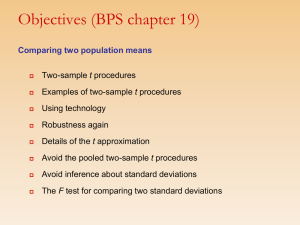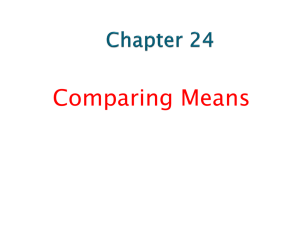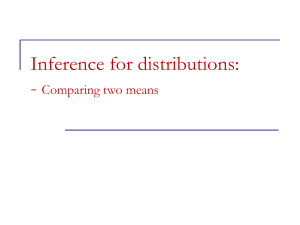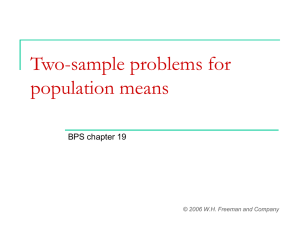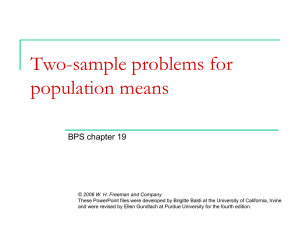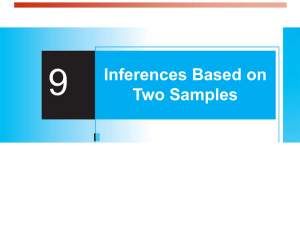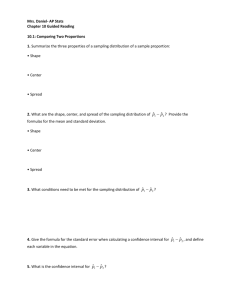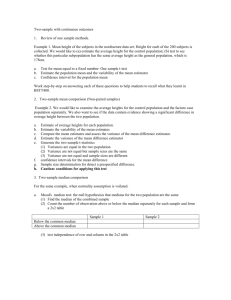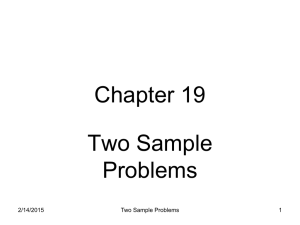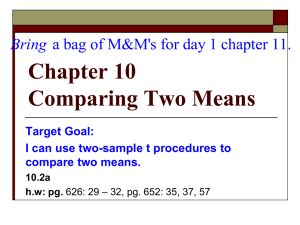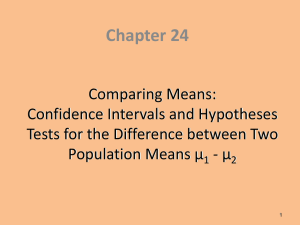Document
advertisement
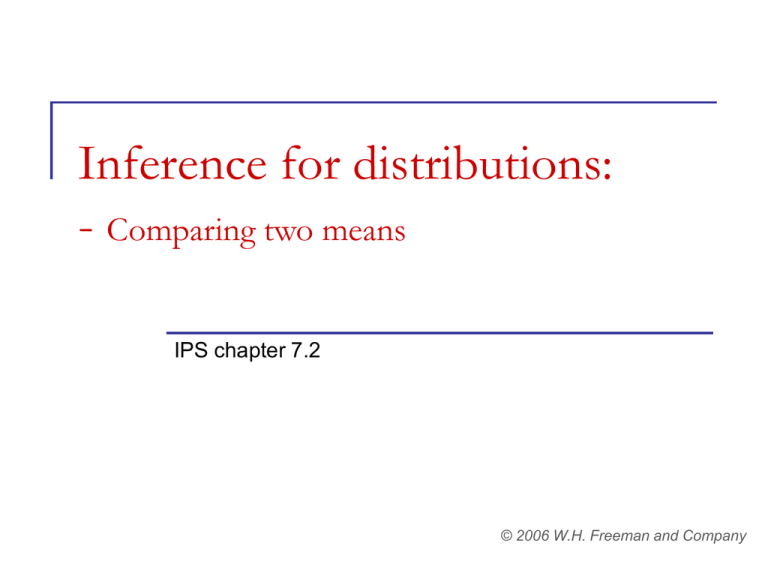
Inference for distributions: - Comparing two means IPS chapter 7.2 © 2006 W.H. Freeman and Company Objectives (IPS chapter 7.2) Comparing two means Two-sample z distribution Two independent samples t-distribution Two sample t-test Two-sample t-confidence interval Robustness Details of the two sample t procedures Comparing two samples (A) Population 1 Population 2 Sample 2 Sample 1 Which is it? (B) Population We often compare two treatments used on independent samples. Sample 2 Sample 1 Is the difference between both treatments due only to variations from the random sampling (B), Independent samples: Subjects in one samples are completely unrelated to subjects in the other sample. or does it reflects a true difference in population means (A)? Two-sample z distribution We have two independent SRSs (simple random samples) coming maybe from two distinct populations with (m1,s1) and (m2,s2). We use and x1 x 2 to estimate the unknown m1 and m2. When both populations are normal, the sampling distribution of (x1− x2) s 12 is also normal, with standard deviation : n1 Then the two-sample z statistic has the standard normal N(0, 1) sampling distribution. z s 22 n2 ( x1 x2 ) ( m1 m 2 ) s 12 n1 s 22 n2 Two independent samples t distribution We have two independent SRSs (simple random samples) coming maybe from two distinct populations with (m1,s1) and (m2,s2) unknown. We use ( x1,s1) and ( x2,s2) to estimate (m1,s1) and (m2,s2) respectively. To compare the means, both populations should be normally distributed. However, in practice, it is enough that the two distributions have similar shapes and that the sample data contain no strong outliers. The two-sample t statistic follows approximately the t distribution with a standard error SE (spread) reflecting SE variation from both samples: s12 s22 n1 n 2 Conservatively, the degrees of freedom is equal to the df smallest of (n1 − 1, n2 − 1). s12 s22 n1 n 2 m 1 -m 2 x1 x2 Two-sample t-test The null hypothesis is that both population means m1 and m2 are equal, thus their difference is equal to zero. H0: m1 = m2 <>m1 − m2 0 with either a one-sided or a two-sided alternative hypothesis. We find how many standard errors (SE) away from (m1 − m2) is ( x1− x 2) by standardizing with t: Because in a two-sample test H0 poses ( m1 −m2) 0, we simply use With df = smallest(n1 − 1, n2 − 1) (x1 x 2 ) (m1 m2 ) t SE t x1 x 2 2 1 2 2 s s n1 n 2 Does smoking damage the lungs of children exposed to parental smoking? Forced vital capacity (FVC) is the volume (in milliliters) of air that an individual can exhale in 6 seconds. FVC was obtained for a sample of children not exposed to parental smoking and a group of children exposed to parental smoking. Parental smoking FVC Yes No x s n 75.5 9.3 30 88.2 15.1 30 We want to know whether parental smoking decreases children’s lung capacity as measured by the FVC test. Is the mean FVC lower in the population of children exposed to parental smoking? H0: msmoke = mno <=> (msmoke − mno) = 0 Ha: msmoke < mno <=> (msmoke − mno) < 0 (one sided) The difference in sample averages follows approximately the t distribution: t 0, 2 2 ssmoke sno n smoke n no , df 29 We calculate the t statistic: t t xsmoke xno 2 2 ssmoke sno nsmoke nno Parental smoking 75.5 88 .2 9.32 15.12 30 30 12.7 3.9 2.9 7.6 FVC x s n Yes 75.5 9.3 30 No 88.2 15.1 30 In table C, for df 29 we find: |t| > 3.659 => p < 0.0005 (one sided) It’s a very significant difference, we reject H0. Lung capacity is significantly impaired in children of smoking parents. Two sample t-confidence interval Because we have two independent samples we use the difference between both sample averages ( x 1 − x2) to estimate (m1 − m2). Practical use of t: t* C is the area between −t* and t*. We find t* in the line of Table C SE for df = smallest (n1−1; n2−1) and the column for confidence level C. The margin of error m is: s12 s22 m t* t * SE n1 n2 s12 s22 n1 n 2 C −t* m m t* Common mistake !!! A common mistake is to calculate a one-sample confidence interval for m1 and then check whether m2 falls within that confidence interval, or vice-versa. This is WRONG because the variability in the sampling distribution for two independent samples is more complex and must take into account variability coming from both samples. Hence the more complex formula for the standard error. SE s12 s22 n1 n2 Can directed reading activities in the classroom help improve reading ability? A class of 21 third-graders participates in these activities for 8 weeks while a control classroom of 23 third-graders follows the same curriculum without the activities. After 8 weeks, all children take a reading test (scores in table). 95% confidence interval for (µ1 − µ2), with df = 20 conservatively t* = 2.086: s12 s22 CI : ( x1 x2 ) m; m t * 2.086 * 4.31 8.99 n1 n2 With 95% confidence, (µ1 − µ2), falls within 9.96 ± 8.99 or 1.0 to 18.9. Robustness The two-sample t procedures are more robust than the one-sample t procedures. They are the most robust when both sample sizes are equal and both sample distributions are similar. But even when we deviate from this, two-sample tests tend to remain quite robust. When planning a two-sample study, choose equal sample sizes if you can. As a guideline, a combined sample size (n1 + n2) of 40 or more will allow you to work even with the most skewed distributions. Details of the two sample t procedures The true value of the degrees of freedom for a two-sample tdistribution is quite lengthy to calculate. That’s why we use an approximate value, df = smallest(n1 − 1, n2 − 1), which errs on the conservative side (often smaller than the exact). Computer software, though, gives the exact degrees of freedom—or the rounded value—for your sample data. s12 s22 n1 n 2 df 2 2 2 2 1 s1 1 s2 n1 1 n1 n 2 1 n 2 2 95% confidence interval for the reading ability study using the more precise degrees of freedom: Table C t-Test: Two-Sample Assuming Unequal Variances Treatment group Control group Mean 51.476 41.522 Variance 121.162 294.079 Observations 21 23 Hypothesized Mean Difference df 38 t Stat 2.311 P(T<=t) one-tail 0.013 t Critical one-tail 1.686 P(T<=t) two-tail 0.026 t Critical two-tail 2.024 t* s12 s22 m t* n1 n2 m 2.024 * 4.31 8.72 SPSS Independent Samples Test Levene's Test for Equality of Variances F Reading Score Equal variances assumed Equal variances not assumed 2.362 Excel Sig. .132 t-test for Equality of Means t 2.267 2.311 df Mean Difference Std. Error Difference .029 9.95445 4.39189 1.09125 18.81765 .026 9.95445 4.30763 1.23302 18.67588 Sig. (2-tailed) 42 37.855 95% Confidence Interval of the Difference Lower Upper Excel menu/tools/data_analysis or =TTEST(array1,array2,tails,type) Array1 is the first data set. Array2 is the second data set. Tails specifies the nature of the alternative hypothesis (1: one-tailed; 2: two-tailed). Type is the kind of t-test to perform (1: paired; 2: two-sample equal variance; 3: two-sample unequal variance). Pooled two-sample procedures There are two versions of the two-sample t-test: one assuming equal variance (“pooled 2-sample test”) and one not assuming equal variance (“unequal” variance, as we have studied) for the two populations. They have slightly different formulas and degrees of freedom. The pooled (equal variance) twosample t-test was often used before computers because it has exactly the t distribution for degrees of freedom n1 + n2 − 2. Two normally distributed populations with unequal variances However, the assumption of equal variance is hard to check, and thus the unequal variance test is safer. When both population have the same standard deviation, the pooled estimator of σ2 is: The sampling distribution for (x1 − x2) has exactly the t distribution with (n1 + n2 − 2) degrees of freedom. A level C confidence interval for µ1 − µ2 is (with area C between −t* and t*) To test the hypothesis H0: µ1 = µ2 against a one-sided or a two-sided alternative, compute the pooled two-sample t statistic for the t(n1 + n2 − 2) distribution. Which type of test? One sample, paired samples, two samples? Comparing vitamin content of bread Is blood pressure altered by use of immediately after baking vs. 3 days an oral contraceptive? Comparing later (the same loaves are used on a group of women not using an day one and 3 days later). oral contraceptive with a group taking it. Comparing vitamin content of bread immediately after baking vs. 3 days Review insurance records for later (tests made on independent dollar amount paid after fire loaves). damage in houses equipped with a fire extinguisher vs. houses Average fuel efficiency for 2005 without one. Was there a vehicles is 21 miles per gallon. Is difference in the average dollar average fuel efficiency higher in the amount paid? new generation “green vehicles”?
